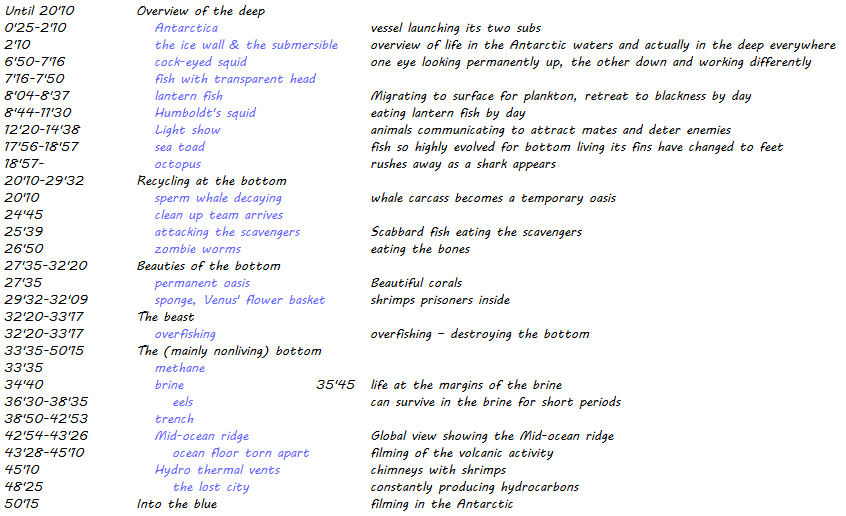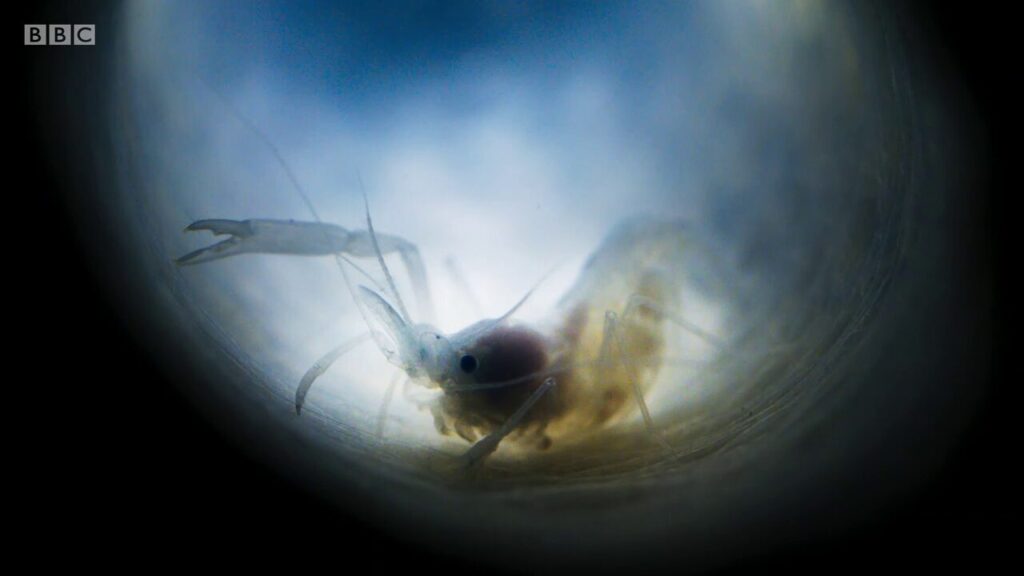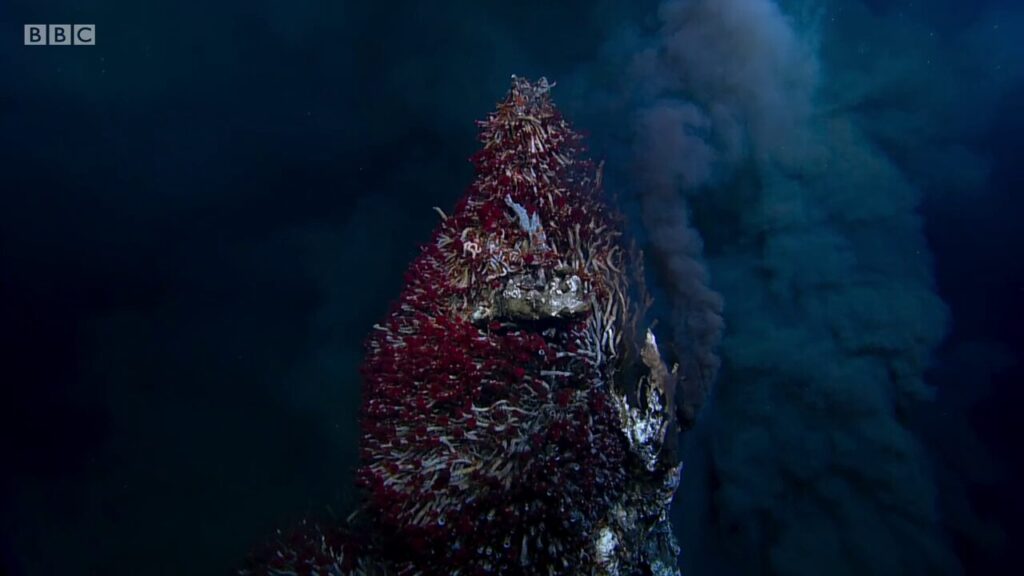Original air date: 5 November 2017


Seeing it in a different way
| Start time | Theme, Contents | More detailed description (Filming location) | Until 20’10 | Introduction | Overview of the deep |
|---|---|---|
| 0’25-2’10 | Further introduction | A vessel launching its two subs |
| 2’10 | The twilight zone: An overview | The ice wall & the submersible: Overview of life in the Antarctic waters and actually in the deep everywhere |
| 6’50 | Cock-eyed squid | The smaller, left eye, facing down, the other larger looking around for prey |
| 7’16-7’50 | Barreleye | Fish with transparent head |
| 8’05 | Lantern fish | Migrating to surface for plankton, then return to darkness by day |
| 8’45-11’30 | Humboldt’s squid | Eating lantern fish by day. When there’s no more to be had they turn on each other |
| 12’20-14’40 | Lights show | Animals communicating to attract mates and deter enemies. This language of light is so widespread that it is probably the most common form of communication on the planet. |
| 17’56 | Sea toad | Fish so highly evolved for bottom living its fins have changed to feet |
| 18’55 | Octopus | Rushes away as a shark appears, being its main prey |
| 20’10-end | The ocean bottom | |
| 20’10-27’35 | Sperm whale decaying | Whale carcass becomes a temporary oasis |
| 20’15 | First arrivals | Sixgill sharks are the first to the scene and in 24 hours 7 of them have eaten a 3rd of the carcass. This meal may last them for a whole year. |
| 24’45 | Clean up team arrives | Spider crabs and rock crabs among them. Sensed them as soon as the sharks but can’t move as fast. A month on and almost 30 species of scavengers have eaten away the carcass. |
| 25’40 | Scabbard fish | Eating the scavengers |
| 26’50 | Zombie worms | Eating the bones |
| 27’35-32’20 | The beauties | The beauty of the bottom is its variety of wildlife |
| 27’35 | Beautiful corals | Permanent oasis |
| 29’30 | Venus’ flower basket | Shrimps imprisoned inside the sponge |
| 32’20-31’20 | The beast | The ugly side of the bottom: the destructive ways humans use to catch their fish, no matter its consequences |
| 32’20 | Overfishing | Destroying the bottom |
| 33’35-50’15 | The (mainly nonliving) bottom | |
| 33’35 | Methane | |
| 34’40 | Brine | Life at the margins of the brine (35’45) |
| 36’30-38’35 | Eels | Can survive in the brine for short periods |
| 38’50 | Trench | |
| 42’55 | Mid-ocean ridge | Global view showing the Mid-ocean ridge: The greatest geological feature on Earth, running right down the middle of the world’s oceans, an underwater mountain range, spanning the entire globe. Scientists think life began in the deep sea. — Attenborough’s approximate words. |
| 43’28 | Ocean floor torn apart | Filming of the volcanic activity in the south Pacific – Over three quarters of Earth’s volcanic activity happens in the deep ocean. But from this violence come great riches … |
| 45’10 | Hydro thermal vents | Chimneys with shrimps. This one, named Godzilla, is 30 metres tall. |
| 48’25 | The lost city | Many such places are now known and every one has its own community. The best known is in The Atlantic where even hydrocarbons – the basic molecules of life – are produced spontaneously. |
| 50’15 | Into the blue | Filming in the Antarctic |
| 58’19 | Total time |
Selected material
The cock-eyed squid

Shrimps inside a sponge

The shrimps presumably arrived as larvae but can’t get out as adults. They’re larvae can, however.
Hydrothermal vents

Minerals and gases gush up through crevices in the Mid-Ocean Ridge and build up chimneys, hydrothermal vents. They can hold as much life as tropical rainforests, half a million individuals per square metre. The animals depend on food from bacteria that have produced them from minerals dissolved in the waters pouring from the vents. To sustain the microbes the animals (crabs or their closely related shrimps, both mentioned in the programme) must dash into the vents – risking that they might be boiled alive !